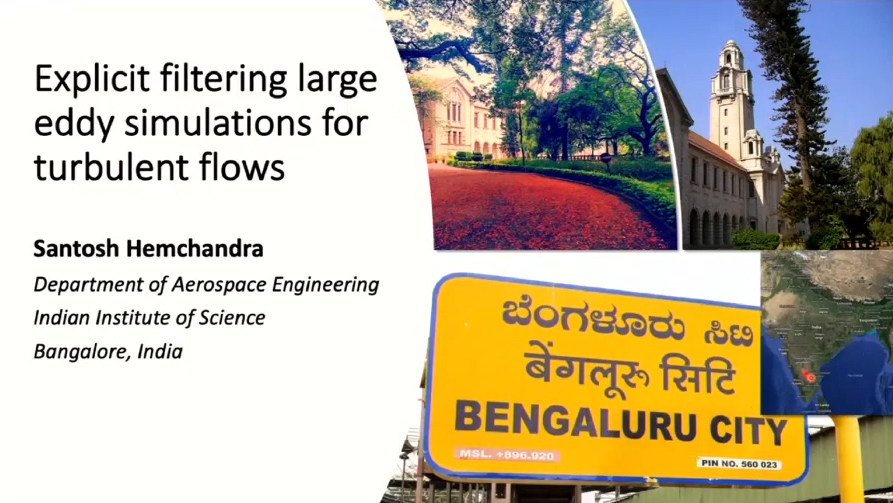'Explicit filtering large eddy simulation for turbulent flows' by Santosh Hemchandra (Indian Institute of Science)
Duration: 56 mins 22 secs
Share this media item:
Embed this media item:
Embed this media item:
About this item

| Description: | Talk given by Dr Santosh Hemchandra (Indian Institute of Science) at Department of Engineering, University of Cambridge, 25 November 2022, as part of the CUED Fluids seminar series. |
|---|
| Created: | 2022-12-06 11:24 |
|---|---|
| Collection: | Cambridge Engineering Dept Fluids Seminars |
| Publisher: | University of Cambridge |
| Copyright: | Dr Santosh Hemchandra |
| Language: | eng (English) |
| Abstract: | Large eddy simulation (LES) for turbulent flows aims to provide physically realistic and time accurate predictions of the dynamics of a range of large length and time scale flow motions. The expectation from this approach is that of achieving improved prediction accuracy of the statistics of flow field quantities over traditional Reynolds/Favre averaged methods while realistically matching available computational resources. Additionally, LES is expected to be a source for training data needed data driven flow prediction and analysis methods. For both these reasons, realizing accurate LES for technologically relevant turbulent flows in realistic geometries is an important research problem.
The explicit filtering LES (EFLES) method formulated by Joseph Mathew at IISc along with Rainer Friedrichs and other colleagues at TU Munich, is one potential approach to achieving reliable LES. EFLES is formally derived from the approximate deconvolution modelling (ADM) approach to LES. Formally, the method involves evolving the flow state using a stable time accurate numerical method and applying a low pass filtering step on the computed fields at every time step. The latter ensures that turbulent kinetic energy generated by large scale resolved motions does not “pile up” at the smallest scale and contaminate the dynamics of large scales. In addition, with mesh refinement, EFLES smoothly reduces to a DNS with no additional modification of the method. The talk will present a recent extension of this method to reacting turbulent flows developed by my research group in IISc and show examples of computations from published and ongoing work. The simulation studies that will be discussed are as follows. First, a premixed turbulent round methane-air jet flame at an equivalence ratio of 0.8 and unburnt gas temperature of 800 K. The nominal 1D premixed flame speed and thermal thickness are, sL=2.0 ms-1 and dL=300 µm respectively. The nominal turbulent Reynolds number, Ret=34 and Karlovitz number, Ka=25, places the flame in the thin reaction zones regime of turbulent premixed combustion. LES and DNS results for flow statistics will be compared for this flame. The second case is a model swirl stabilized gas turbine combustor, PRECCINSTA at DLR Stuttgart with a nozzle flow Re=24,000. In addition to comparing flows statistics with experimental measurements for this case, I will also present results comparing characteristics of coherent self-excited large scale flow dynamics using spectral POD of measured and LES data. These results demonstrate the validity of using EFLES for turbulent reacting flows. |
|---|---|
Available Formats
| Format | Quality | Bitrate | Size | |||
|---|---|---|---|---|---|---|
| MPEG-4 Video | 1600x720 | 1.98 Mbits/sec | 837.26 MB | View | Download | |
| MPEG-4 Video | 800x360 | 574.71 kbits/sec | 237.27 MB | View | Download | |
| WebM | 1600x720 | 976.42 kbits/sec | 403.23 MB | View | Download | |
| WebM | 800x360 | 268.24 kbits/sec | 110.78 MB | View | Download | |
| iPod Video | 480x360 | 474.15 kbits/sec | 195.75 MB | View | Download | |
| MP3 | 44100 Hz | 249.78 kbits/sec | 103.46 MB | Listen | Download | |
| Auto * | (Allows browser to choose a format it supports) | |||||

